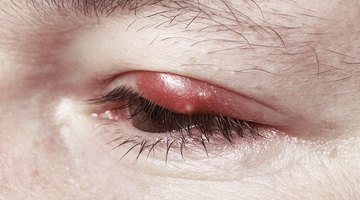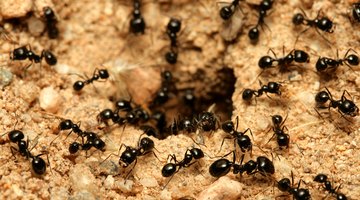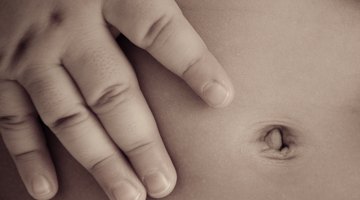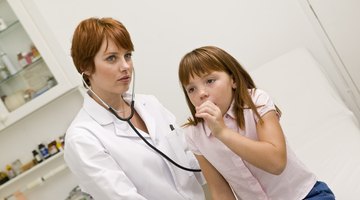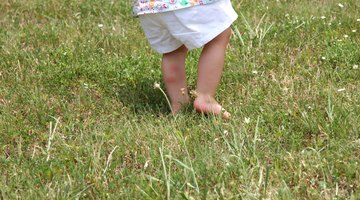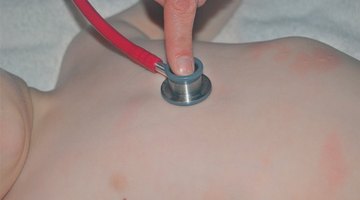Rash Under Arm in Toddlers
Your toddler has been playing all day, and now there's a mysterious rash under his arm.
If a rash appears under your toddler’s arm with no other symptoms, it could be from contact dermatitis, atopic eczema or even Lyme disease. Always consult your doctor for proper diagnosis and treatment if a rash is present on your toddler.
Identification
Contact dermatitis and atopic eczema have similar symptoms. Both develop into a red rash that may blister and have dry patches. The itching can be severe for both types of rashes.
Contact dermatitis is a short-term rash; atopic eczema is long term, and can result in thickened skin from your toddler scratching the itchy rash over a long period of time. Atopic eczema usually starts on the face and extends to other areas of the body, but it can be found anywhere, such as under your toddler’s arm. A rash associated with Lyme disease, meanwhile, will look like a red bull's-eye and will be warm to touch. The identifying Lyme disease rash may be all that’s present, but other symptoms include facial paralysis, pain in the large joints, fatigue and swollen lymph nodes.
Causes

A Toddler With Redness on the Face
Learn More
Contact dermatitis is caused by an irritant or an allergen. After repeated contact with an irritant, skin will become inflamed. Examples of irritants are fragranced skin products, rough materials, rubber, weeds and chemicals.
If the substance that causes the rash is an allergen, the rash is more severe. The same irritants can be allergens; metals are also common allergens.
Your toddler’s immune system identifies a substance as being harmful and releases chemicals to destroy the invader.
Once an allergy is developed, your child will always be allergic to this substance. The cause of atopic eczema is unknown as of 2011, but it’s most common if your toddler has family members with eczema, asthma or hay fever. Lyme disease is spread by a blacklegged tick that’s infected with the bacteria Borrelia burgdorferi, according to the Centers for Disease Control and Prevention.
Treatment
Hydrocortisone creams can be prescribed to relieve itching and inflammation for contact dermatitis and atopic eczema; antihistamines can also offer relief for itching. Consult your pediatrician before treating your toddler with any medication, as some might not be suitable for young children. If your toddler scratches the rash, it can cause further irritation or a secondary bacterial infection — so keep your toddler’s nails short to minimize scratching. If your toddler has contact dermatitis, a cool bath in baking soda, uncooked oatmeal or colloidal oatmeal can offer relief.
If your child has atopic eczema, meanwhile, applying a fragrance free ointment several times per day to moisturize the skin can offer significant relief.
Atopic eczema will usually clear by the time your child turns 6, the PubMed Health website reports. The rash associated with Lyme disease rarely causes discomfort and the condition is treated with antibiotics.
Prevention

Redness on the Face in Children
Learn More
The best way to prevent contact dermatitis is to avoid irritants and allergens. Only use products that are free of dyes, perfumes and chemicals for your toddler. If your toddler is playing outside, keep him away from weeds and high grass. Have your toddler wear smooth cotton clothing.
If your toddler does come in contact with an irritant, promptly wash the area with soap and water. Apply a moisturizer for a protective barrier to the skin.
To prevent flare-ups of atopic eczema, limit your toddler’s bath time to 10 minutes in cool water. Do not scrub your toddler’s skin with a washcloth or towel. Apply ointment as soon as your toddler gets out of the bath. Keep a humidifier in your home.
Prevent Lyme disease by avoiding wooded areas and applying repellents containing at least 20 percent DEET; consult your pediatrician to make sure your repellent is safe for use on your toddler. A tick must be attached for 24 hours to transmit Lyme disease, so always thoroughly check your toddler for ticks after outdoor playtime if you live in northeastern or north-central areas of the United States.


